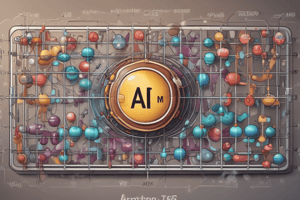Podcast
Questions and Answers
What defines a neutral atom?
What defines a neutral atom?
- It has more electrons than protons.
- It has more protons than electrons.
- It has an equal number of protons and electrons. (correct)
- It has an equal number of neutrons and protons.
Which of the following describes an ion?
Which of the following describes an ion?
- An atom where the number of electrons equals the number of neutrons.
- An atom with no charge.
- An atom where the number of electrons does not equal the number of protons. (correct)
- An atom with a different number of neutrons than protons.
What is the charge of a sulfate ion?
What is the charge of a sulfate ion?
- 2+
- 1+
- 3-
- 2- (correct)
How can isotopes of an atom be defined?
How can isotopes of an atom be defined?
What characterizes cations?
What characterizes cations?
Flashcards
Isotopes
Isotopes
Atoms of the same element with a different number of neutrons but the same number of protons. This means they have the same atomic number but different mass numbers.
Valence Shell
Valence Shell
The outermost shell of an atom where electrons occupy and participate in chemical bonding.
Cation
Cation
A positively charged ion formed by the loss of electrons.
Anion
Anion
Signup and view all the flashcards
Ionic Bonding
Ionic Bonding
Signup and view all the flashcards
Signup and view all the flashcards
Study Notes
Atomic Structure - Chemistry
-
Subatomic particles: protons, neutrons, electrons
-
Protons are found in the nucleus, with a positive charge and relative mass of 1
-
Neutrons are found in the nucleus, with no charge and relative mass of 1
-
Electrons are found in the shells, with a negative charge and relative mass of 0.0005
-
RAM - (MIXAD) + (M2KA2)... = 100
-
Neutral atom - number of protons = number of electrons
Polyatomic Ions
- Ammonium - NH4+
- Hydroxide - OH-
- Nitrate - NO3-
- Sulfate - SO42-
- Carbonate - CO32-
- Phosphate - PO43-
Atomic Number, Mass Number, Isotopes
- Atomic number = number of protons
- Mass number = number of protons + number of neutrons
- Isotopes are atoms of the same element with different numbers of neutrons
Ions and Charges
- Cations are positively charged ions (formed by losing electrons)
- Anions are negatively charged ions (formed by gaining electrons)
- Ions form by changing the number of electrons
Types of Bonding
- Ionic bonding - electrostatic force of attraction between oppositely charged ions
- Covalent bonding - electrostatic force of attraction between shared pair of electrons and the nuclei in both atoms
Other Terms
- PEN numbers - protons, electrons, neutrons
- Isotope - atoms with the same proton number but different neutron number
- Valence shell- outermost shell of electrons
Studying That Suits You
Use AI to generate personalized quizzes and flashcards to suit your learning preferences.
Description
Test your knowledge on atomic structure, subatomic particles, and polyatomic ions in this chemistry quiz. Explore concepts like atomic number, mass number, and charge of ions, enhancing your understanding of fundamental chemistry principles.




